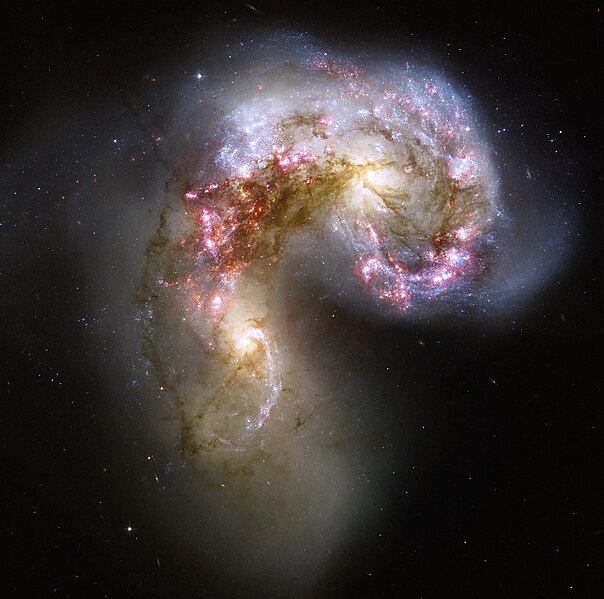Plaetje:Antennae galaxies xl.jpg

Gruutde van dees veurvertuining: 604 × 599 pixels. Anger resoluties: 242 × 240 pixels | 484 × 480 pixels | 774 × 768 pixels | 1.032 × 1.024 pixels | 2.064 × 2.048 pixels | 3.915 × 3.885 pixels.
Oearsprunkelik bestandj (3.915 × 3.885 pixels, besjtandjgruutde: 14,64 MB, MIME-type: image/jpeg)
Besjtandjshistorie
Klik op 'ne datum/tied om 't besjtand te zeen wie 't destieds waor.
| Datum/tied | Miniatuurplaetje | Aafmaetinge | Gebroeker | Opmirking | |
|---|---|---|---|---|---|
| hujig | 23 apr 2007 20:05 |  | 3.915 × 3.885 (14,64 MB) | WilliamKF | == Description == This new NASA Hubble Space Telescope image of the Antennae galaxies (NGC 4038 & 4039) is the sharpest yet of this merging pair of galaxies. During the course of the collision, billions of stars will be formed. The brightest and most comp |
Bestandjsbroek
Dit besjtandj weurt op de volgende pagina's gebroek:
Globaal besjtandjsgebroek
De volgende anger wiki's gebroeke dit bestandj:
- Gebroek in af.wikipedia.org
- Gebroek in ar.wikipedia.org
- مجرة
- بوابة:علم الفلك/تصنيفات
- مقراب هابل الفضائي
- تشكل وتطور المجرات
- مجرة انفجار نجمي
- فهرس المجرات وعناقيد المجرات
- فهرس كالدويل
- ويكيبيديا:صور مختارة/الفضاء والكون/نظرة إلى الأعلى
- بوابة:علم الفلك/صورة مختارة
- أطلس المجرات الغريبة
- بوابة:نجوم/مجرة
- ويكيبيديا:ترشيحات الصور المختارة/مجرتا الهوائيات
- ويكيبيديا:صورة اليوم المختارة/أبريل 2018
- قالب:صورة اليوم المختارة/2018-04-23
- بوابة:علم الفلك/صورة مختارة/60
- NGC 4038
- ويكيبيديا:صورة اليوم المختارة/أبريل 2020
- قالب:صورة اليوم المختارة/2020-04-23
- ويكيبيديا:صورة اليوم المختارة/مارس 2023
- قالب:صورة اليوم المختارة/2023-03-04
- Gebroek in ar.wiktionary.org
- Gebroek in arz.wikipedia.org
- مجره
- بوابة:علم الفلك/تصنيفات
- ESO 499 12 (مجره)
- VCCA 42 (مجره)
- LEDA 21644 (مجره)
- LEDA 83336 (مجره)
- LEDA 42596 (مجره)
- UGC 7485 (مجره)
- SDSSCGB 31599.1 (مجره)
- LEDA 2458152 (مجره)
- ESO 138 9 (مجره)
- NGC 3887 (مجره)
- ان جى سى 4697 (مجره)
- NGC 2549 (مجره)
- NGC 1249 (مجره)
- NGC 4517 (مجره)
- IC 3499 (مجره)
- IC 3446 (مجره)
- IC 1251 (مجره)
- IC 625 (مجره)
- NGC 3924 (مجره)
- UGC 1198 (مجره)
- NGC 4350 (مجره)
- NGC 4951 (مجره)
- ان جى سى 1515 (مجره)
Bekiek wikiwied gebroek van dit bestandj.


